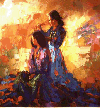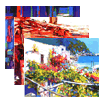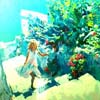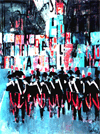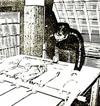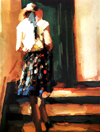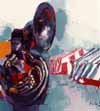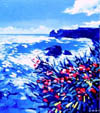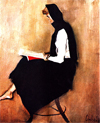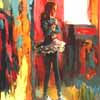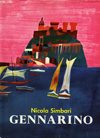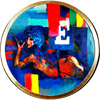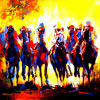Excerpts from an article in Palm Beach Life, March 1984, written by journalist Frank Getlein, underlines The Artist in Simbari - - - with the heading - - -
|
“Ending the myth that good art is created
by those who starve . . . The success of
Nicola
Simbari”
|
<<<“The “artist’s” life has been celebrated by artists as Johann Strauss the Younger, Giacomo Puccini, Emile Zola and Joyce Cary. But every artist, of course, writes the story all over again according to his own times, his personality, his talent and his fortune - - good or bad.
Perhaps the happiest and most rewarding version of the artist’s life in our time is one still being written by Palm Beach’s favourite artist - - Nicola Simbari. His life is sunny, as immediately attractive and as complex in structure as his paintings and prints.
In Italy, home to all the arts of our civilization, an Italian can grow up to be an artist as another might grow up to be a shoemaker or an accountant, confident that his work will have a place in society. If lucky, he may expect a reasonable livelihood from his effort, and, if he is very good and finds widespread public appreciation, he may even become rich.
Simbari grew up in that tradition, having early-on revealed that he was very good and had revealed to him that his work did indeed please a very wide public. As a result, he lives (and has lived for many years) in the wonderful formulation of Picasso, “like a poor man who happens to have lots of money.”>>>
<<< Simbari entered the Fine Arts Academy in Rome at the age of 13 and studied there for four full years. No one would characterise his work as academic in any sense, but he feels grateful to the Academy for a fundamental grounding in the unchanging principles and techniques of drawing and painting. “Sometimes,” he recollects, “we would spend six months merely drawing to perfection the plaster copy of an antique hand or foot.” The training, for which he is grateful, shows in his work - - not in anything resembling such a meticulous student drawing, but in the mastery of drawing, that underlies every stroke of paint.
In 1949, at age 22, he took the decisive step of setting up his own studio on the Via Babuino. He had his first one-man show in the Asterisco Gallery in Rome and designed sets for the musical Tarantella Napolitana, for which he received a national prize.
Shortly thereafter, he moved up to the venerable, and venerated, Obelisco Gallery and crossed the continent for a one-man show in London.
He painted murals for the Italian Pavilion at the Brussels’ World Fair, travelled and painted in France and Spain, executed a lithograph on commission, for clients in Zurich and, most important of all, married Elfrida Kerbey, the woman who in many ways changed his life (as indeed, she changed her own, marrying him).”>>>
|
Simbari in his Rome Studio . . . .the artist at work in his studio |
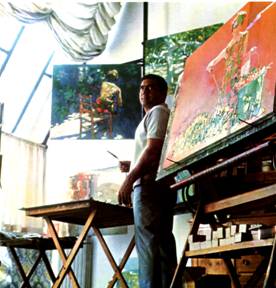 |
|
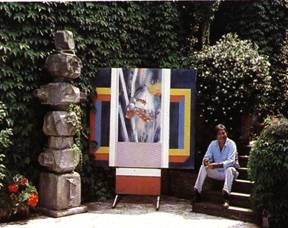 |
. . . sitting outside his
studio Sculptures by Amerigo Tot and Simbari |
From an article in VOGUE DECORATION “Les Grands Createurs”
|
“THE
SOLAR EYE”
|
|
“Simbari :
a
world unto himself . . . his brilliant painting reaches beyond
the visible. An artist out to conquer the world, and therefore, himself.” |
<< Simbari is one of those rare artists who put things in their proper perspective; he knows that the world of painting, no matter what we may say of it, shall always be where the artist meets reality head-on.
And so, from canvas to canvas over the years, Nicola Simbari will participate in some formidable battles; his abilities and his panache concealing both the risk and the stresses of his particular point of view. In spite of his innate mettle and his look of victorious chieftain, he is never certain of victory. Off to conquer the world, and himself in the bargain, he cannot cease, and will not. Indefatigable, he instead starts to broaden horizons of which he dreams in excessive terms; leaving behind for us to enjoy.
Look closer . . . there is more to Simbari’s art than the voluptuous and carefree sum of what is evident in his work. The wild symphony of colours and forms that is immediately apparent should not mask the essentials of his message. It has to do with the deeply-knowing way he has of leading our eye exactly to where it would be, were we in his place as the artist. Then everything around this point becomes fluid, softened, and the painters hand disappears as we reach more deeply into the painting. Just as in certain of Rembrandt’s self-portraits, where reality exists at the exact distance which separates the work of art from the viewer. Nicola Simbari has become the master of his technique, creating a fascinating sorcery.
A good painting is what remains after the artist has removed himself. An absence that is not just mere politeness, but evidence that the artist has succeeded; the painting can substitute for its subject matter.
Simbari’s road is dotted with these successes. Each time, they carry him further along his special voyage, while we continue to be fascinated, and eager for more.”
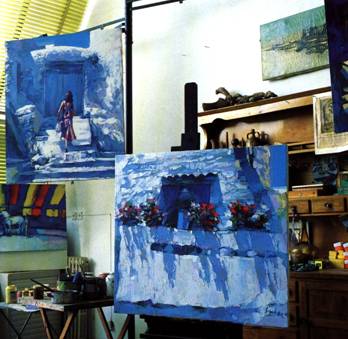 |
The Artist's Studio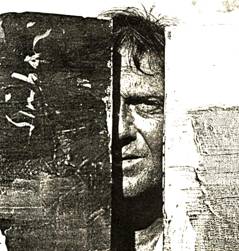
The Artist’s “eye” . . . . . . his “solar eye” |
|
The
Magician of Colour
|
From VOGUE Decoration October 1987
<< Frascati, set on the face of the Alban Hills, with its rich vineyards bathed in the misty heat of the mid-day sun, seems to look down on the Plains of Rome with nonchalance. A solitary train winds its way past green gardens with their sleepy white villas. It is in one of these villas that Nicola Simbari has made his new Studio. His colours sparkle in the cool half-light of the house, where from basement to attic unframed paintings are everywhere. Simbari has created a superb oasis far from the hustle and bustle of the ‘80s’.>>
<< A union between Neo-realism and Semi-abstract, figures appear and disappear, furtive and fascinating, exploding with light and colour, applied by a skillful palette-knife with swift bold strokes. Since his debut in the ‘50s’, Simbari has mastered this powerful technique, often underlined by the use of dark opaque tones, to intensify the burst of vibrant colour. He attacks to canvas without the need to sketch, and the discipline he learned from his studies at the Accademia delle Belle Arti, Rome, has given him this remarkable command of his Art.>>
| << His paintings are moving – unforgettable – a touch of life. >> |
|
SIMBARI at his Studio
in Rome
|
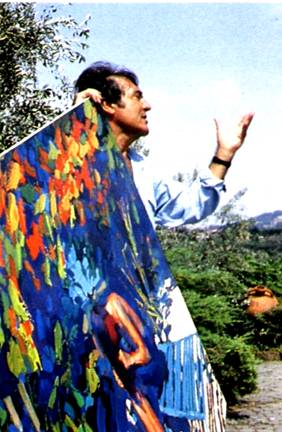 |
Many people are unaware that Simbari not only created the images for his magnificent ‘Retablos in Silkscreen’ (commonly referred to as ‘serigraphs’) but also created the prints in his own printing studio in Frascati. After working with various printing studios and feeling unsatisfied with the results, he bought a ‘villa’, near to his own house, and set up his ‘print shop’, which he called a ‘Bottega d’arte’. He went to Germany to find the best silkscreen machines on the market. Then he drove Fabriano, in the Marche, north-east of Rome, to choose the best cotton-rag paper, which has been produced there for hundreds of years. He arranged to have his name run through the large sheets of paper, so that there could not be any ‘copies’ made, at a future date. And then ‘production’ commenced - - - ‘limited editions’ of this period are truly limited - - and I was given the task of creating the Certificates of Authenticity and the leaflets for the 30 plus editions he created.
|
SIMBARI creating the Retablo
“Lily” in 1981 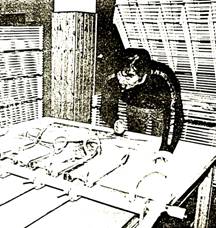
|
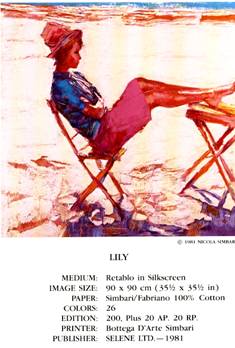 |
Excerpt from AVENUE (the New York Magazine)
<< It is the love of life that distinguishes the art of Nicola Simbari. The strength of his palette knife and the simplicity of his subjects has continued to capture the eye and imagination of the beholder since his first exhibition in Rome in 1949. Simbari is a Master of his Art in the true fashion of the Renaissance Artist.>>
<< In a recent interview, Simbari related that “Art is my reason for living - - - Life is the reason for my Art” The images projected on his canvasses are testimony to this statement. Here is an artist who has never wavered from the desire to share with the world what he loves . . . be it a beach in the Mediterranean, a street scene in Paris, or the excitement of the Circus or a nightclub. >>
<< Henry McIlhenny and Julius Fleischmann were among the first to recognise an extra-ordinary talent and encouraged Simbari with their patronage. C.V. Whitney, Mrs Charles Shipman Payson, and Count Theo Rossi di Montelera followed as patrons and collectors, as did Mr. Acram Ojjeh, in the more recent years. This is to name only a few of the impressive list of collectors from all walks of life, over the years, who have delighted in Simbari’s unique art.>>
|
“Simpatia” Oil on Canvas ©SIMBARI |
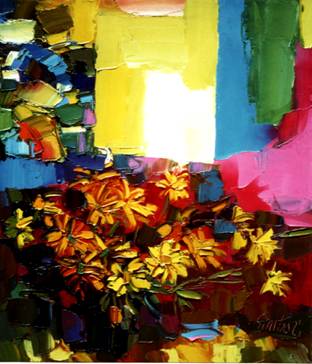 |
|
On this page I hope that I
have brought some of the excitement, and colour, of being the ‘side-kick’ of SIMBARI, the Artist . . . the Master Artist . . . the Magician of Light and Colour ! |
 |
© Elfrida 2010
Back to the top



